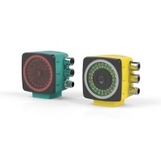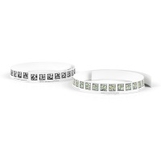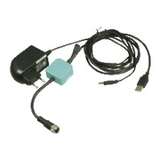The PCV, PXV, safePXV, and safePXV/PUS Data Matrix positioning systems from Pepperl+Fuchs use Data Matrix codes for precise positioning. They consist of a 2-D camera system—a read head—and a Data Matrix code tape or metal code bar. This unique combination ensures maximum precision and extremely reliable positioning.
The self-adhesive code tape or metal code bar is attached to a fixed part of the system or plant, such as the wall of an elevator shaft or the mounting rail of an electric monorail system (EMS). The 2-D read head is mounted on a "vehicle" that moves parallel to it, e.g., on the elevator car or on the carrier of the EMS. Code redundancy and large reading windows enable the PCV, PXV, safePXV, and safePXV/PUS Data Matrix positioning systems to reliably detect a position, even if the code tape is dirty or damaged. They can also bridge code tape gaps without any problems.
The systems differ in reading window and Data Matrix code size: PXV, safePXV, and safePXV/PUS offer even greater mounting tolerance with their large reading windows. The positioning systems can be parameterized via Data Matrix code cards, PC, or the controller, which makes them easy to get up and running. Typical applications for Data Matrix positioning systems include the positioning of skid and electric monorail systems, lifting and elevator systems, studio technology, and cranes.
Safety Guaranteed: Safe Versions safePXV and safePXV/PUS
With the safePXV and safePXV/PUS, Pepperl+Fuchs offers two safety versions of the PXV positioning system that enable safe absolute positioning up to SIL 3/PL e. The safePXV positioning system is based on a combination of 2-D camera technology and multicolor Data Matrix code tape. The preinstalled firmware checks the plausibility of the X position values using red and blue illumination color in combination with a mulitcolor code tape. The safe X position data can then be processed in the PLC without additional plausibility checks—all because of the reliable, self-monitoring sensor technology.
The safePXV/PUS positioning system consists of the safe evaluation unit (Position Unit Safe, PUS) and a safePXV/PUS read head. The evaluation unit acts as a safe gateway to the fieldbus: It processes the redundant signals from the safePXV/PUS read head, creates a safe position X value, and derives a safe speed value from it. In addition to the safe and non-safe data, it also transmits diagnostic data, Y tolerance warnings, or a quality rating of the code tape. The system supports the common safety protocols PROFINET & PROFIsafe and EtherCAT®/Fail Safe over EtherCAT® (FSoE) in order to transmit the acquired data from the sensor to a safe control system. The safe X position or safe speed can be used to realize common safety functions such as safe limited position (SLP) or safe limited speed (SLS) by the supervising SPLC or other.
Portfolio

The positioning system’s 2-D read heads detect position via the Data Matrix codes printed on the code tape. Using state-of-the-art camera technology, they measure an exact absolute position in X with a resolution of 0.2 mm over large distances of up to 100,000 m. With additional diagnostic data such as Y coordinates and a code tape quality assessment, they ensure maximum reliability. Pepperl+Fuchs offers read heads for a range of requirements. For safety applications, users can select between the safePXV read head and the safePXV/PUS read head which is combined with a safe evaluation unit (PUS).

The read head records position information from the Data Matrix codes printed on the code tape or metal code bar and outputs it as X, Y position values. The code tape can be tailored to the application, with any starting position and a total length of up to 100,000 m. This makes the Data Matrix positioning systems even suitable for large systems and complex routes.

A positioning system also needs the right accessories. In addition to read heads and code tape, the Data Matrix positioning system portfolio also includes the appropriate connection cables, mounting aids, and programming cable sets for connecting to the Vision Configurator parameterization software, for instance.

Benefits
- The best and most reliable absolute positioning system in the world—a unique combination of 2-D camera and Data Matrix code tape
- Noncontact positioning at up to 100,000 m
- Uncompromising reliability: multi-code redundancy provides resistance to contamination and damage
- Fast and flexible installation with adhesive code tape, a wide reading window, and large depth of field
- Quick and easy parameterization via RS-485, SSI, EtherNet/IP, PROFINET, PROFIsafe, or EtherCAT®/Fail Safe over EtherCAT® (FSoE)
- safePXV and safePXV/PUS for safety applications up to SIL 3/PL e







 +86 10 5901 7000
+86 10 5901 7000